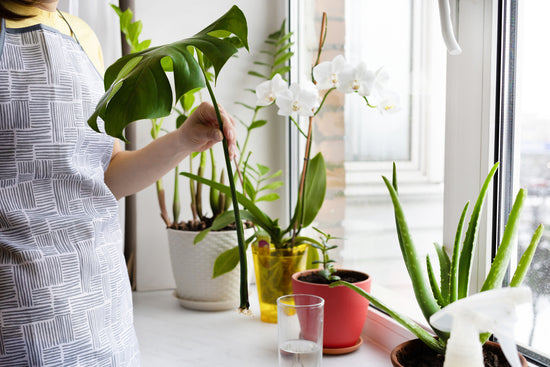While Sansevieria sounds fancy it’s the common names that makes them seems like they have always been a part of your family. More popularly referred to as the snake plant, mother-in-law’s tongue, and more, they are not one of easiest but the easiest plant to care for. With their long spathe like leaves that grow tall in a concentric pattern, the sansevieria has very basic requirements as far as water, light, and fertilisers are concerned. You can literally just put them in a corner and marvel at them every day.
If you have ever seen a sansevieria, it must have instantly caught your attention with its uncomplicated leaf design. Tall, lance like, erect leaves of green rising perpendicular from the ground up. The leaves sometimes have variegations or come in different shades depending on the species of sansevieria in question. It is one of the best air-purifying plants you can have at home (NASA certified). The best choice for new gardeners and those who are looking for more architectural aesthetic in their green spaces.
Let’s take a look at the care tips and learn how to make the Snake Plant become the centre piece in your home.
Common name: Snake plant, Mother-in-law’s tongue, Viper's bowstring hemp, St. George's sword
Botanical name: Dracaena trifasciata (formerly Sansevieria trifasciata)
Sunlight: Partial sun to Low light
Air: Well ventilated
Soil: Sandy and well-draining
Water: When the soil dries out completely.
Fertilisers: Once every month. No fertilisers in winter
Issues: Rot due to overwatering. It does better with underwatering.
Sunlight for snake plant
For the Snake plant, direct sunlight is not required and extended exposure might burn the leaves. It can live happily in anything from partial sunlight on windowsills to low light corners of your bedrooms. Brighter light ensures faster growth on this generally slow growing houseplant and if your sansevieria is variegated, then the bands shine brighter with light. Brighter light also ensures healthier plants. While the plants can live happily in the lowest of lights, itleads to slower growth, smaller leaves, and much slower growth
Placement of Snake Plant
The Snake Plant will do great in almost any corner of your home, from your shaded patios to your dark aisles. If your sansevieria is smaller, place it on tabletops, shelves, or windowsills. The larger plants look good anywhere large enough to keep them. Their erect compact growth make them a great fit for tight corners that have nothing going on for them. Even if you are placing your snake plant in really low light corners, sunning it weekly for a couple of hours gives them enough fuel to stay healthy and keep you happy.

Watering for Snake Plant
Snake plants are drought resistant plants that have rhizomatous roots. The thick leaves store water for long spells of dryness. This plant does better with underwatering than overwatering. Water your snake plant only when the entire potting mix is dry. The watering reduces significantly in winter (to almost once a month) as it’s the dormant period for the plant. The frequency of watering depends on the amount of light it gets, plants in brighter light need more frequent watering and vice versa.
When watering an extremely dried out soil (visible cracks and soil leaving the planter walls) water in batches. Watering all at once allows the water to simply pass through the soil without getting absorbed, so water in batches and let the soil soak it all up.
Every time a plant I watered, water it thoroughly till you see some draining out of the drainage hole and always empty the under plate.

Fertilisers for Snake Plant
Feed your Sansevieria with a generic houseplant fertiliser every three to four weeks, diluted as instructed on the packaging. Make sure the fertilisers have the three major nutrients, nitrogen, phosphorous, and potassium. Ugaoo’s Plan-T-onic and NPK are great options for both root and foliar applications. Another great way to add nutrition to the soil is through monthly addition of vermicompost or any other organic compost.
Propagation of Snake Plant
Sansevieria plants can be propagated through separation of pups and leaf cuttings.
Once smaller plants sprout around the main mother plant, wait for them to reach a respectable size, and develop their own root system. Unpot the plant and divide the root rhizome to separate the mother plant from the pups and pot them both separately.
For propagating through leaf cuttings, use a sharp shear to take at least a 4 inch tall cutting from a leaf and place it in water with the right side up in a well-lit place. Ensure that the cutting Is placed in the same direction it was growing. Change the water when it gets cloudy. You will see roots and new leaves sprouting in a few weeks.

Potting and Repotting Snake Plant
When potting, choose a strong pot as the snake plant roots are famous for cracking through fragile materials. Snake plants is a slow grower and rarely needs repotting, but they might grow rapidly with the appropriate light conditions and need repotting or dividing. The best time to repot these plants is in the spring. When repotting, always use fresh potting soil, a cactus potting mix, or a mixture of both.
Plant problems for Snake Plant
Scales, gnats, spider mites, aphids, mealybugs, and whiteflies are common snake plant pests. You can avoid an insect invasion if you keep your plant healthy. If you notice insects on your plant, remove the insects by picking them off, by using a gentle spray of water, or with an organic neem oil to keep the insects at bay.
Foul smelling and constantly wet soil is a clear indication of root rot. Unpot your soil and wash the roots to check for rot. Cut away any black/brown and soft roots and retain the white healthy parts. Repot in a fresh well-draining potting mix and water rarely.
Curling leaves are a sign of thrip infestation. These tiny black bugs are easy to deal with. Cut away severely curled leaves and spray the plant with neem oil or vegetable soap to keep the pests at bay. New leaves will eventually grow.
Yellowing leaves that are falling over are due to overwatering or poor light. Water scarcely and only when he potting mix is entirely dry. If your plant in a very low-light area then either move it to a brighter spot or put it in the sun for few hours every week.
Happy Gardening!!!












